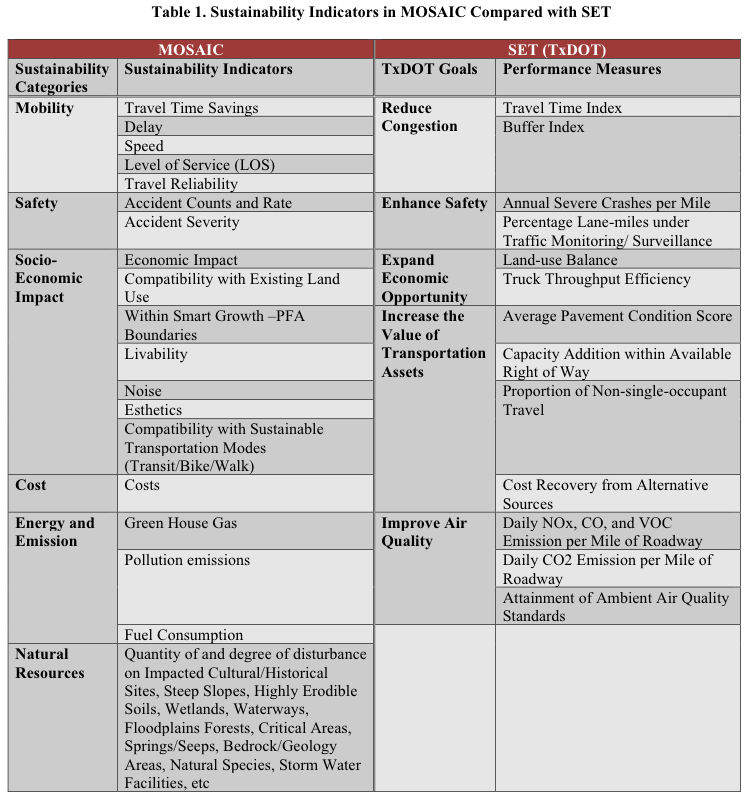MARYLAND STATE HIGHWAY ADMINISTRATION
Chapter 1: Introduction
The SHA is committed to integrating safety, mobility, environmental stewardship, and socio-economic objectives into its transportation planning process through its Comprehensive Highway Corridors (CHC) program. To support its sustainability initiatives, SHA has funded the development of a Model Of Sustainability And Integrated Corridors (MOSAIC), which defines sustainability indicators, analyzes the sustainability impact of corridor improvements, and identifies environmental mitigation needs early in the planning process. The sustainability indicators include mobility, safety, air quality, energy consumption, natural resource impact, pollution and green house gas emissions, socio-economics and cost. When implemented during the highway needs assessment and long-range planning stages, MOSAIC can help SHA identify the corridor improvement option that best balances these sustainability indicators. Also, it avoids options with major negative environmental impacts that often lead to costly and lengthy environmental screening and mitigation procedures. MOSAIC is different from microscopic traffic simulation (e.g Synchro, Vissim) and EPA emission models (e.g. MOVES) that provide detailed pollution and green house gas (GHG) emission estimates for a particular project with a predetermined improvement type; instead, MOSAIC integrates sustainability objectives before the selection of an improvement type. Furthermore, it incorporates a more comprehensive set of sustainability indicators and provides high-level impact analysis with minimum requirements on staff time and other resources.
A transportation corridor planning study usually consists of several sequential steps that include problem identification, determination of goals and evaluation criteria, development/evaluation of initial alternatives, development/evaluation of detailed alternatives, financial analysis, alternative selection, transportation plan updates, project development and project implementation. The affected communities and interested stakeholders may also be involved in each corridor-planning step. This is essential because the greatest benefits and the most streamlined process of transportation corridor improvements are obtained when the relevant agencies and stakeholders are involved early in the planning process. Also, the environmental impact mitigation needs to be provided in a proactive and systematic fashion, the multiple corridor projects need to be considered at the program level (instead of on a project-by-project basis), and decisions need to be driven by clear goals and objectives, high-quality data, and valid objective modeling tools.
For instance, the concept of “environmental banking” allows highway agencies to provide mitigation in advance of the actual needs for replacement/restoration of wetlands and habitat. A negative impact in one corridor can be balanced cost-effectively by a benefit in another corridor. However, the successful application of such proactive measures would require prior knowledge of the likely sustainability impact of multiple corridor improvement projects, so that the appropriate type and amount of mitigation can be planned ahead systematically.
This project report summarizes the methods employed in MOSAIC for estimating the sustainability impacts of various corridor improvement options. These impacts are categorized into six major groups: mobility, safety, socio-economic, natural resources, energy and emissions, and cost. Phase Two of the project focused on comparing the sustainability impact of both the no-build case and ten additional multimodal corridor improvement options, including adding general purpose lanes, upgrading at-grade intersections to grade-separated interchanges, road diet (i.e. lane removal), high occupancy vehicle (HOV) lane, high occupancy toll (HOT) lane, bus rapid transit/bus-only lane, light rail transit, truck-only lane, and express toll lane.
After an extensive review of the literature and best practices, along with several discussions with SHA project liaisons and other SHA staff members, the UMD research team defined a comprehensive set of sustainability indicators that are incorporated and quantitatively evaluated in MOSAIC (see Table 1). For comparison purposes, the sustainability indicators adopted by the Texas DOT for its Sustainability Enhancement Tool (SET) are listed in Table 1.
The remainder of the project report is organized as follows: Chapter 2 summarizes and briefly discusses new mode choice models developed in phase two of the MOSAIC project that are necessary for multimodal corridor planning; Chapters 3 through 9 document the technical details of various MOSAIC input/output and analysis modules; Chapter 10 presents the findings from a case study that applies multimodal MOSAIC to the US 29 corridor between the DC-Maryland border (just south of I-495) and I-70; and finally, Chapter 11 provides a research roadmap to present planned future development of the MOSAIC tool, as well as its integration with the SHA enterprise GIS system for enhanced user friendliness.
Read full report (PDF) here: Comprehensive Highway Corridor Planning with Sustainability Indicators
About the Maryland State Highway Administration (SHA)
www.roads.maryland.gov
“SHA Mission: Provide a safe, well-maintained, reliable highway system that enables mobility choices for all customers and supports Maryland’s communities, economy and environment.”
Tags: Comprehensive Highway Corridor Planning with Sustainability Indicators, Maryland State Highway Administration, SHA







 RSS Feed
RSS Feed